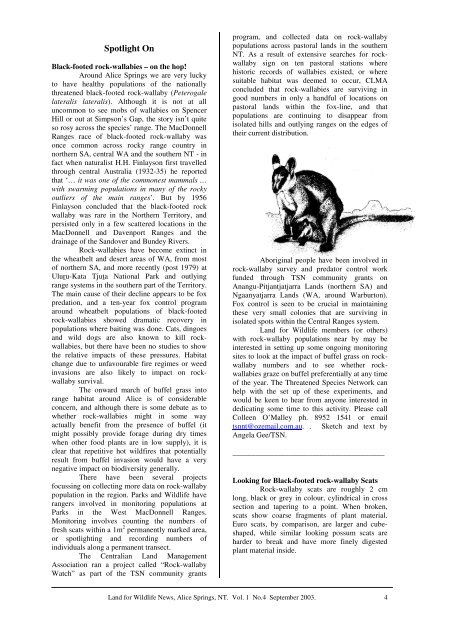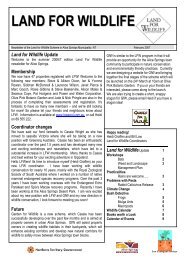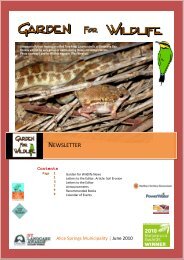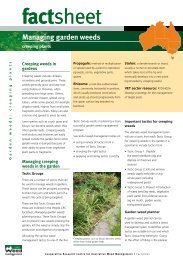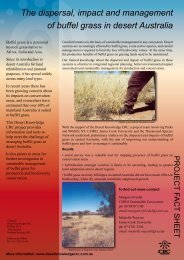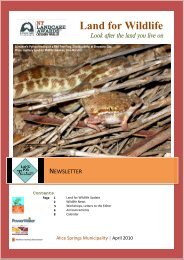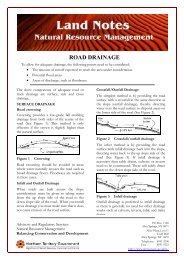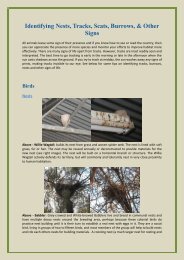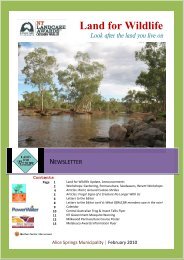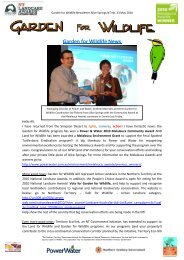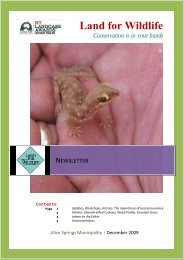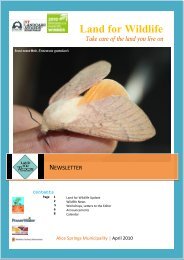LAND FOR WILDLIFE NEWS - Low Ecological Services
LAND FOR WILDLIFE NEWS - Low Ecological Services
LAND FOR WILDLIFE NEWS - Low Ecological Services
You also want an ePaper? Increase the reach of your titles
YUMPU automatically turns print PDFs into web optimized ePapers that Google loves.
Spotlight On<br />
Black-footed rock-wallabies – on the hop!<br />
Around Alice Springs we are very lucky<br />
to have healthy populations of the nationally<br />
threatened black-footed rock-wallaby (Peterogale<br />
lateralis lateralis). Although it is not at all<br />
uncommon to see mobs of wallabies on Spencer<br />
Hill or out at Simpson’s Gap, the story isn’t quite<br />
so rosy across the species’ range. The MacDonnell<br />
Ranges race of black-footed rock-wallaby was<br />
once common across rocky range country in<br />
northern SA, central WA and the southern NT - in<br />
fact when naturalist H.H. Finlayson first travelled<br />
through central Australia (1932-35) he reported<br />
that ‘… it was one of the commonest mammals …<br />
with swarming populations in many of the rocky<br />
outliers of the main ranges’. But by 1956<br />
Finlayson concluded that the black-footed rock<br />
wallaby was rare in the Northern Territory, and<br />
persisted only in a few scattered locations in the<br />
MacDonnell and Davenport Ranges and the<br />
drainage of the Sandover and Bundey Rivers.<br />
Rock-wallabies have become extinct in<br />
the wheatbelt and desert areas of WA, from most<br />
of northern SA, and more recently (post 1979) at<br />
Uluru-Kata Tjuta National Park and outlying<br />
range systems in the southern part of the Territory.<br />
The main cause of their decline appears to be fox<br />
predation, and a ten-year fox control program<br />
around wheatbelt populations of black-footed<br />
rock-wallabies showed dramatic recovery in<br />
populations where baiting was done. Cats, dingoes<br />
and wild dogs are also known to kill rockwallabies,<br />
but there have been no studies to show<br />
the relative impacts of these pressures. Habitat<br />
change due to unfavourable fire regimes or weed<br />
invasions are also likely to impact on rockwallaby<br />
survival.<br />
The onward march of buffel grass into<br />
range habitat around Alice is of considerable<br />
concern, and although there is some debate as to<br />
whether rock-wallabies might in some way<br />
actually benefit from the presence of buffel (it<br />
might possibly provide forage during dry times<br />
when other food plants are in low supply), it is<br />
clear that repetitive hot wildfires that potentially<br />
result from buffel invasion would have a very<br />
negative impact on biodiversity generally.<br />
There have been several projects<br />
focussing on collecting more data on rock-wallaby<br />
population in the region. Parks and Wildlife have<br />
rangers involved in monitoring populations at<br />
Parks in the West MacDonnell Ranges.<br />
Monitoring involves counting the numbers of<br />
fresh scats within a 1m 2 permanently marked area,<br />
or spotlighting and recording numbers of<br />
individuals along a permanent transect.<br />
The Centralian Land Management<br />
Association ran a project called “Rock-wallaby<br />
Watch” as part of the TSN community grants<br />
program, and collected data on rock-wallaby<br />
populations across pastoral lands in the southern<br />
NT. As a result of extensive searches for rockwallaby<br />
sign on ten pastoral stations where<br />
historic records of wallabies existed, or where<br />
suitable habitat was deemed to occur, CLMA<br />
concluded that rock-wallabies are surviving in<br />
good numbers in only a handful of locations on<br />
pastoral lands within the fox-line, and that<br />
populations are continuing to disappear from<br />
isolated hills and outlying ranges on the edges of<br />
their current distribution.<br />
Aboriginal people have been involved in<br />
rock-wallaby survey and predator control work<br />
funded through TSN community grants on<br />
Anangu-Pitjantjatjarra Lands (northern SA) and<br />
Ngaanyatjarra Lands (WA, around Warburton).<br />
Fox control is seen to be crucial in maintaining<br />
these very small colonies that are surviving in<br />
isolated spots within the Central Ranges system.<br />
Land for Wildlife members (or others)<br />
with rock-wallaby populations near by may be<br />
interested in setting up some ongoing monitoring<br />
sites to look at the impact of buffel grass on rockwallaby<br />
numbers and to see whether rockwallabies<br />
graze on buffel preferentially at any time<br />
of the year. The Threatened Species Network can<br />
help with the set up of these experiments, and<br />
would be keen to hear from anyone interested in<br />
dedicating some time to this activity. Please call<br />
Colleen O’Malley ph. 8952 1541 or email<br />
tsnnt@ozemail.com.au. . Sketch and text by<br />
Angela Gee/TSN.<br />
________________________________________<br />
Looking for Black-footed rock-wallaby Scats<br />
Rock-wallaby scats are roughly 2 cm<br />
long, black or grey in colour, cylindrical in cross<br />
section and tapering to a point. When broken,<br />
scats show coarse fragments of plant material.<br />
Euro scats, by comparison, are larger and cubeshaped,<br />
while similar looking possum scats are<br />
harder to break and have more finely digested<br />
plant material inside.<br />
Land for Wildlife News, Alice Springs, NT. Vol. 1 No.4 September 2003. 4


